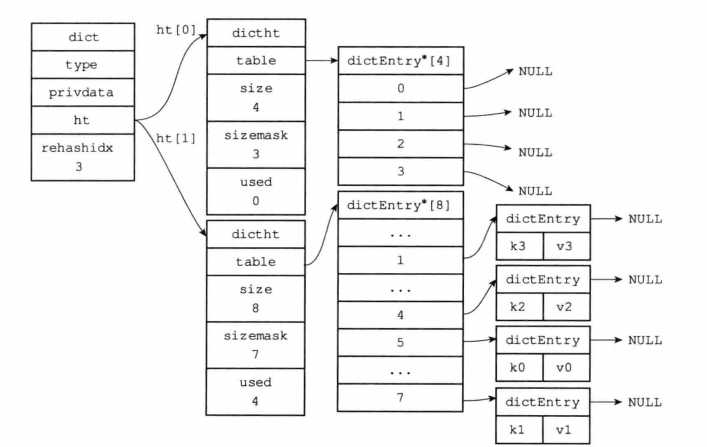标签:兴趣 并且 个数 images tab 构造 eve signed bucket
说到redis的Dict(字典),虽说算法上跟市面上一般的Dict实现没有什么区别,但是redis的Dict有2个特殊的地方那就是它的rehash(重新散列)和它的字典节点单向链表。
以下是dict用到的结构:
typedef struct dictEntry {//字典的节点 void *key; union {//使用的联合体 void *val; uint64_t u64;//这两个参数很有用 int64_t s64; } v; struct dictEntry *next;//下一个节点指针 } dictEntry; typedef struct dictType { unsigned int (*hashFunction)(const void *key); //hash函数指针 void *(*keyDup)(void *privdata, const void *key); //键复制函数指针 void *(*valDup)(void *privdata, const void *obj); //值复制函数指针 int (*keyCompare)(void *privdata, const void *key1, const void *key2); //键比较函数指针 void (*keyDestructor)(void *privdata, void *key); //键构造函数指针 void (*valDestructor)(void *privdata, void *obj); //值构造函数指针 } dictType; /* This is our hash table structure. Every dictionary has two of this as we * implement incremental rehashing, for the old to the new table. */ typedef struct dictht { //字典hash table dictEntry **table;//可以看做字典数组,俗称桶bucket unsigned long size; //指针数组的大小,即桶的层数 unsigned long sizemask; unsigned long used; //字典中当前的节点数目 } dictht; typedef struct dict { dictType *type; void *privdata; //私有数据 dictht ht[2]; //两个hash table int rehashidx; /* rehashing not in progress if rehashidx == -1 */ //rehash 索引 int iterators; /* number of iterators currently running */ //当前该字典迭代器个数 } dict;
由于楼主算法能力有限:所以对哈希算法没有太深的了解,所以在这里算法就不详写了,大家有兴趣可以百度。
当运用哈希算法计算出 k0的索引 ,redis就会插入到指定的位置

当k2和k1出现计算出键索引相同的情况下,这时候redis的dictEntry(字典节点)有一个next属性(单项链表),redis会把冲突键索引的元素排到后插入数据的前面,从而解决了这个问题

现在如果在插入2条元素,此时数据量已经超过dict的负载了,redis就会启用rehash,虽然是rehash操作但是redis是采用了渐进式操作,并不是一下子内存不够用了 就直接操作内存,然后全部转移数据,这样会导致操作很耗时,redis考虑到了这一点,然后
先把ht[1]另一张dict结构中扩容一个数量为ht[0].used*2的dictEntry数组,然后把2条数据通过哈希算法加入到这个数组中。

然后把上面的元素一个个异步渐渐移动到下面的数组中,在这个过程中如果客户端去操作元素时,如果在ht[0]中检查找不到建,就会去检查ht[1]中是否有指定的键,从而不影响数据的使用,而且可以避免一次性操作rehash带来的耗时问题,最后reshash完成了,就直接把ht[1]和ht[0]切换位置并且清空弃用的哈希节点数组,从而完成所有操作。


redis数据结构存储Dict设计细节(redis的设计与实现笔记)
标签:兴趣 并且 个数 images tab 构造 eve signed bucket
原文地址:http://www.cnblogs.com/QDSBK/p/6159200.html